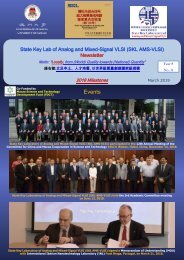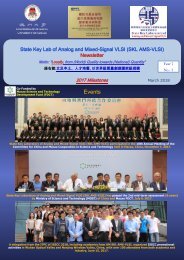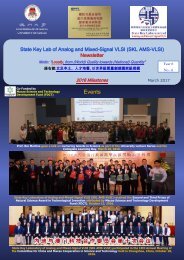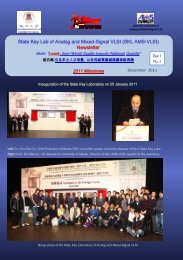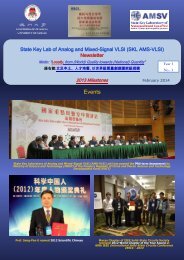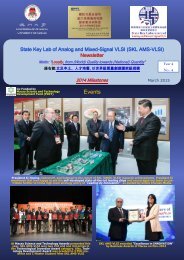AMSV Newsletter 2015
AMSV Newsletter 2015
AMSV Newsletter 2015
You also want an ePaper? Increase the reach of your titles
YUMPU automatically turns print PDFs into web optimized ePapers that Google loves.
In IEEE Transactions on Electron Devices <strong>2015</strong><br />
A Precision CMOS Voltage Reference Exploiting Silicon Bandgap<br />
Narrowing Effect<br />
Bo Wang, Man-Kay Law and Amine Bermak<br />
From Wireless research line<br />
Motivation<br />
Architecture<br />
Conventional precision voltage references<br />
(BGRs) can be achieved by multiple temperature<br />
trimmings and/or power hungry curvature<br />
correction circuits that inevitably increases cost<br />
and energy efficiencies. We exploit the intrinsic<br />
temperature characteristics of the BJT itself to<br />
reduce the BJT curvature and perform curvature<br />
correction using the silicon bandgap narrowing<br />
effect so as to avoid the power overhead of curvature<br />
correction circuits by batch trimming.<br />
Measurement results show that the BJT curvature<br />
can be effectively reduced from its inherent<br />
3.6 mV to 1.4 mV. The proposed BGR measures<br />
a minimum temperature coefficient of 8.7 ppm/°<br />
C and 4.1 ppm/°C from −55 °C to 125 °C after<br />
batch trimming and curvature trimming, respectively.<br />
Proposed BGR Topology with curvature reduction using bandgap<br />
narrowing effect<br />
Relationship between voltage and temperature showing the curvature reduction<br />
and correction with convex (left) and concave (right) BJT intrinsic curvatures.<br />
Implementation<br />
Verification<br />
(a)<br />
Complete schematic of the proposed BGR using bandgap narrowing effect.<br />
(b)<br />
Chip micrograph of the proposed BGR<br />
(a) Inaccuracy of V REF from 12 samples without trimming and after batch<br />
trimming resistor R c1 at 25 °C (dotted lines indicates ± 3σ values); (b)<br />
Measured BJT intrinsic curvature and V REF before and after the curvature<br />
compensation.




